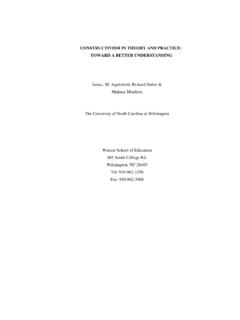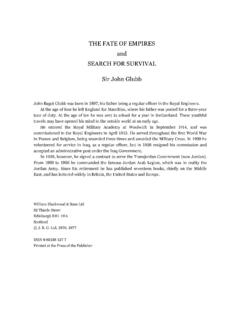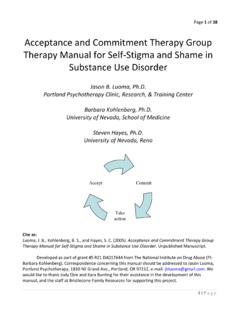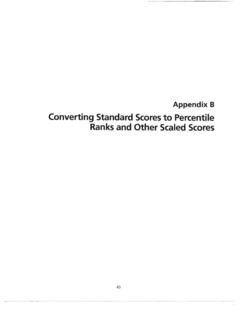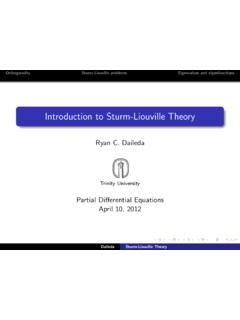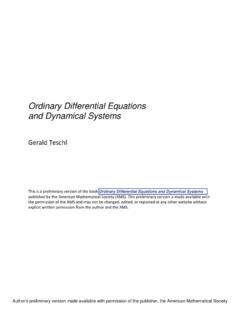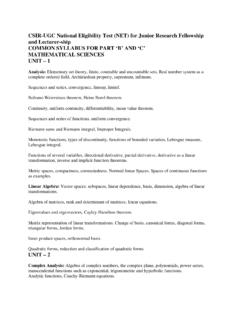Transcription of 6 Sturm-Liouville Eigenvalue Problems
1 6 Sturm-Liouville Eigenvalue IntroductionIn the last chapters we have explored the solution of boundary value problemsthat led to trigonometric eigenfunctions. Such functions can be used to repre-sent functions in Fourier series expansions. We would like to generalize someof those techniques in order to solve other boundary value Problems . A class ofproblems to which our previous examples belong and which have eigenfunc-tions with similar properties are the Sturm-Liouville Eigenvalue Problems involve self-adjoint (differential) operators which play an im-portant role in the spectral theory of linear operators and the existence of theeigenfunctions we described in Section These ideas will be introducedin this physics many Problems arise in the form of boundary value problemsinvolving second order ordinary differential equations. For example, we mightwant to solve the equationa2(x)y +a1(x)y +a0(x)y=f(x)( )subject to boundary conditions.
2 We can write such an equation in operatorform by defining the differential operatorL=a2(x)d2dx2+a1(x)ddx+a0(x).Then , Equation ( ) takes the formLy= we saw in the general boundary value problem ( ) in Section ,we can solve some equations using Eigenvalue expansions. Namely, we seeksolutions to the Eigenvalue problemL = 186 6 Sturm-Liouville Eigenvalue Problemswith homogeneous boundary conditions and then seek a solution as an expan-sion of the eigenfunctions. Formally, we lety= n=1cn , we are not guaranteed a nice set of need anappropriate set to form a basis in the function space. Also, it would be niceto have orthogonality so that we can easily solve for the expansion coefficientsas was done in Section [Otherwise, we would have to solve a infinitecoupled system of algebraic equations instead of an uncoupled and diagonalsystem.]It turns out that any linear second order operator can be turned into anoperator that possesses just the right properties (self-adjointedness to carryout this procedure.)
3 The resulting operator is referred to asa sturm -Liouvilleoperator. We will highlight some of the properties of such operators and provea few key theorems, though this will not be an extensive review of Sturm-Liouville theory . The interested reader can review the literature and moreadvanced texts for a more in depth define theSturm- liouville operatorasL=ddxp(x)ddx+q(x).( )TheSturm- liouville Eigenvalue problemis given by the differential equationLu= (x)u,orddx(p(x)dudx)+q(x)u+ (x)u= 0,( )forx (a, b).The functionsp(x), p (x), q(x) and (x) are assumed to becontinuous on (a, b) andp(x)>0, (x)>0 on [a, b]. If the interval is finiteand these assumptions on the coefficients are true on [a, b], then the problemis said to beregular. Otherwise, it is also need to impose the set of homogeneous boundary conditions 1u(a) + 1u (a) = 0, 2u(b) + 2u (b) = 0.
4 ( )The s and s are constants. For different values, one has special typesofboundary conditions. For i= 0, we have what are calledDirichlet boundaryconditions. Namely,u(a) = 0 andu(b) = i= 0, we haveNeumannboundary conditions. In this case,u (a) = 0 andu (b) = terms of theheat equation example, Dirichlet conditions correspond tomaintaining a fixedtemperature at the ends of the rod. The Neumann boundary conditions Introduction 187correspond to no heat flow across the ends, or insulating conditions, as therewould be no temperature gradient at those points. The more general boundaryconditions allow for partially insulated type of boundary condition that is often encountered is thepe-riodic boundary condition. Consider the heated rod that has been bent toform a circle. Then the two end points are physically the same. So, we wouldexpect that the temperature and the temperature gradient should agree atthose points.
5 For this case we writeu(a) =u(b) andu (a) =u (b).Boundaryvalue Problems using these conditions have to be handled differently than theabove homogeneous conditions. These conditions leads to different types ofeigenfunctions and previously mentioned, equations of the form ( ) occur often. We nowshow that Equation ( ) can be turned into adifferential equation of Sturm-Liouville form:ddx(p(x)dydx)+q(x)y=F(x).( )Another way to phrase this is provided in the theorem:Theorem second order linear operator can be put into the form ofthe Sturm-Liouville operator ( ).The proof of this is straight forward, as we shall soon show. Consider theequation ( ). Ifa1(x) =a 2(x),then we can write the equation in the formf(x) =a2(x)y +a1(x)y +a0(x)y= (a2(x)y ) +a0(x)y.( )This is in the correct form. We just identifyp(x) =a2(x) andq(x) =a0(x).However, consider the differential equationx2y +xy + 2y= this casea2(x) =x2anda 2(x) = 2x6=a1(x).
6 The linear differentialoperator in this equation is not of Sturm-Liouville type. But, we can changeit to a sturm liouville the sturm liouville operator the derivative terms are gathered togetherinto one perfect derivative. This is similar to what we saw inthe first chap-ter when we solved linear first order equations. In that case we sought anintegrating factor. We can do the same thing here. We seek a multiplicativefunction (x) that we can multiply through ( ) so that it can be written inSturm- liouville form. We first divide out thea2(x), givingy +a1(x)a2(x)y +a0(x)a2(x)y=f(x)a2(x).Now, we multiply the differential equation by :188 6 Sturm-Liouville Eigenvalue Problems (x)y + (x)a1(x)a2(x)y + (x)a0(x)a2(x)y= (x)f(x)a2(x).The first two terms can now be combined into an exact derivative ( y ) if (x) satisfiesd dx= (x)a1(x)a2(x).This is formally solved to give (x) =e a1(x)a2(x) , the original equation can be multiplied by factor (x)a2(x)=1a2(x)e a1(x)a2(x)dxto turn it into Sturm-Liouville summary,Equation ( ),a2(x)y +a1(x)y +a0(x)y=f(x),( )can be put into the Sturm-Liouville formddx(p(x)dydx)+q(x)y=F(x),( )wherep(x) =e a1(x)a2(x)dx,q(x) =p(x)a0(x)a2(x),F(x) =p(x)f(x)a2(x).
7 ( )Example the example above,x2y +xy + 2y= need only multiply this equation by1x2e dxx=1x,to put the equation in Sturm-Liouville form:0 =xy +y +2xy= (xy ) +2xy.( ) Properties of Sturm-Liouville Eigenvalue Problems Properties of Sturm-Liouville Eigenvalue ProblemsThere are several properties that can be proven for the (regular) Sturm-Liouville Eigenvalue problem . However, we will not prove them all here. Wewill merely list some of the important facts and focus on a fewof the The eigenvalues are real, countable, ordered and there isa smallest eigen-value. Thus, we can write them as 1< 2< ..However, there is nolargest Eigenvalue andn , n .2. For each Eigenvalue nthere exists an eigenfunction nwithn 1 zeroson (a, b).3. Eigenfunctions corresponding to different eigenvalues are orthogonal withrespect to the weight function, (x). Defining the inner product off(x)andg(x) as< f, g >= baf(x)g(x) (x)dx,( )then the orthogonality of the eigenfunctios can be written in the form< n, m>=< n, n> nm, n, m= 1,2.
8 ( )4. The set of eigenfunctions is complete; , any piecewise smooth func-tion can be represented by a generalized Fourier series expansion of theeigenfunctions,f(x) n=1cn n(x),wherecn=< f, n> < n, n>.Actually, one needsf(x) L2 [a, b],the set ofsquare integrable functionsover [a, b] with weight function (x).By square integrable, we mean that< f, f > < .One can show that such a space is isomorphic to aHilbertspace, a complete inner product Multiply the Eigenvalue problemL n= n (x) nby nand integrate. Solve this result for n,to find theRayleigh Quotient n= p nd ndx|ba ba[p(d ndx)2 q 2n]dx< n, n>The Rayleigh quotient is useful for getting estimates of eigenvalues andproving some of the other 6 Sturm-Liouville Eigenvalue ProblemsExample seek the eigenfunctions of the operator found in Namely, we want to solve the Eigenvalue problemLy= (xy ) +2xy= y( )subject to a set of boundary conditions.
9 Let s use the boundary conditionsy (1) = 0, y (2) = 0.[Note that we do not know (x) yet, but will choose an appropriate functionto obtain solutions.]Expanding the derivative, we havexy +y +2xy= through byxto obtainx2y +xy + (2 + x )y= that if we choose (x) =x 1,then this equation can be made aCauchy-Euler type equation. Thus, we havex2y +xy + ( + 2)y= characteristic equation isr2+ + 2 = oscillatory solutions, we need + 2> , the general solution isy(x) =c1cos( + 2 ln|x|) +c2sin( + 2 ln|x|).( )Next we apply the boundary (1) = 0 forcesc2= (x) =c1cos( + 2 lnx).The second condition,y (2) = 0,yieldssin( + 2 ln 2) = will give nontrivial solutions when + 2 ln 2 =n , n= 0,1,2,3..In summary, the eigenfunctions for this Eigenvalue problemareyn(x) = cos(n ln 2lnx),1 x Properties of Sturm-Liouville Eigenvalue Problems 191and the eigenvalues are n= 2 +(n ln 2)2forn= 0,1,2.
10 Note: We include then= 0 case becausey(x) = constant is a solutionof the = 2 case. More specifically, in this case the characteristic equationreduces tor2= , the general solution of this Cauchy-Euler equation isy(x) =c1+c2ln|x|.Settingy (1) = 0, forcesc2= 0. y (2) automatically vanishes, leaving thesolution in this case asy(x) = note that some of the properties listed in the beginning ofthe sectionhold for this example. The eigenvalues are seen to be real, countable andordered. There is a least one, = , one can find the zeros of eacheigenfunction on [1,2]. Then the argument of the cosine,n ln 2lnx,takes values0 ton forx [1,2].The cosine function hasn 1 roots on this can be checked as well. We set up the integral and use thesubstitutiony= lnx/ln gives< yn, ym>= 21cos(n ln 2lnx)cos(m ln 2lnx)dxx=ln 2 0cosnycosmy dy=ln 22 n,m.( ) Adjoint OperatorsIn the study of the spectral theory of matrices, one learns about the adjoint ofthe matrix,A , and the role that self-adjoint, or Hermitian, matrices play indiagonalization.
